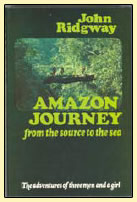
 |
 |
 |
Books
Home
Biographies
Books
Expeditions
Self-catering Holidays
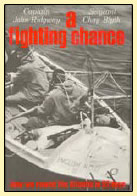 |
A FIGHTING CHANCE Written by John Ridgway and Chay Blyth Paul Hamlyn 1966 & Pan Paberback 1968 “The winds built up up till it was gale force. We have been using the jets and props going to Shannon as a guide. We can’t be far away now. All day we hear them. I was rowing about 0900 hours; John was making breakfast. He stood up. ‘Land’ he said. I wouldn’t look. ‘I’ll wait till we get closer’, I said. The weather closed in then. We worked out it could only be the Aran Islands. The rain started to pour down. Both oars came out. We had approximately nine hours of daylight left. The seas were getting bigger all the time. About 1400 hours we could make out the cliffs. I started preparing the packs for an emergency landing. We were both singing now. I believe we hadn’t come 3,000 miles to find death on a cliff.” (From Chay Blyth’s log book). Perhaps this was the single most dramatic day of my life. On that wild Saturday in September 1966, Chay and I set eyes on the storm-lashed Aran Islands. After months of glare off the sea, the memory of the vivid green grass will stay with me forever. With only the slightest difference in our landfall, wind and tide would have dashed us onto the rocks. I remember watching the spray flying upward in the storm, hundreds of feet up and over the tops of the cliffs. How can I express how plain lucky we were? There was no way we could stop the wind driving us at the islands; straining at all four oars we simply had to keep the bows pointing into the wind, trying to guide the boat into the narrow channel which led to safety. At dusk we landed at the little Irish village of Inishmore after rowing across the Atlantic in a tiny boat only twenty feet long and five feet wide. We couldn’t have made it by night: what a difference a few hours made in a 92-day voyage. Chay and I had had a fairly robust army training as paratroopers, but neither of us had much experience of the sea. Our little boat, English Rose III, was like a Cape Cod dory – the sort of open boat traditionally used by fishermen off the east coast of America. The dory men who made her ready, promised us ‘a fighting chance’ – and we certainly needed it. For three months, without shelter or bedding, we lived in a cockpit measuring eight feet by four feet. Using ‘O’ Level Navigation, I took sights of the sun with my trusty sextant, from just four feet above the sea. English Rose III was battered by storms, by hurricane Alma, by huge and almost overwhelming waves. Salt water gave us boils and got into the rations, food became short. Basking sharks wider than the boat, sheltered from the sun beneath the hull. And whales wider than the boat was long, swept under us in the fog. On moonless nights, the luminous wake of speeding dolphins almost persuaded us they were sea serpents. At that stage in our lives, the intense solitude brought a new dimension to life, and the struggle to keep going and keep alive gave us a greater awareness of true values. Postscript This was a hard trip for two young fellows. But we were young and hopeful – I don’t suppose we would have been there otherwise. It wasn’t simply being in a small open boat in miserable conditions for three months…though I do remember sucking boiled sweets through their wrapping paper when the food began to run out. But mostly I remember David Johnstone and John Hoare, who were making the same voyage that year. They set out a few days before us, from Norfolk Virginia. Months later their upturned boat was found in the middle of the North Atlantic. They have been dead for nearly 40 years now. I have tried to look on every day since that voyage as a bonus. It could so easily have been the two of us who died. This voyage changed the course of our lives. |
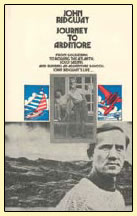 |
JOURNEY TO ARDMORE Written by John Ridgway Hodder & Stoughton 1971 Paperback 1971 But Life had other plans. “What are you going to do next?” was the question I was always being asked for the next 40 years. In 1968, I found myself alone in a thirty-foot sailing boat, the first to start, of the nine men who set out that summer, on a race to become the first man to sail alone non-stop round the world. At sea again, after all the fuss following the rowing trip, I tried again to plan the future for Marie Christine and me. Perhaps we could run the adventure school at Ardmore for half of each year and spend the other six months re-charging our batteries on an expedition. In the confines of that small boat, I felt I was wishing my life away, counting the bubbles in the wake. I wanted to explore mountains, jungles and rivers. Meanwhile, the race turned out to become something of an epic. Only one man was to reach the finish; two committed suicide, one on the trip and the other shortly afterwards. The rest of us crawled ashore on various parts of the globe. I pitched up in Brazil and made my way home to Ardmore, eager to begin building the school. Postscript This book came about by accident. The publishers had commissioned a book about my attempt to sail alone non-stop round the world but a collision with a television trawler at the start put paid to that. So it was decided I should take a shot at writing an autobiography. I remember sitting down at a folding card table in our little tin house in the wood on Ardmore. I picked up my fountain pen and looked at the crisp new pad of lined foolscap, and panicked. Then I looked out of the kitchen window, down the narrow slate-grey sea loch and on up toward the Foinaven ridge: an autobiography after only thirty years seemed a rather long shot. But on the dresser beside me were the two leather-bound diaries containing the past ten years of my life. They made all the difference. This book tells of my childhood. In social terms it is about values of long ago: I never mentioned that I was an adopted child, my parents would have been horrified to see that in print. I was 45 years old when I dared ask my Father if my younger brother Michael was my natural brother or not. Families are strange things. Perhaps much of drive springs from memories of those early days; fishing alone on the Thames, rowing miles up the river from Datchet to Windsor, and swimming downstream, towing the boat. Always alone. Five years at the Nautical College, Pangbourne led to an early start on a brief spell in the Merchant Navy. My two years at RMA Sandhurst were a turning point for me. Becoming Captain of Boxing led to my being the first officer commissioned directly into the Third Battalion of the Parachute Regiment. And being hounded by able, ambitious senior officers taught me valuable lessons for the future, even if only how to hide in doorways until they had passed. Only dead fish swim with the stream.
|
|
AMAZON JOURNEY Written by John Ridgway Hodder & Stoughton 1972 The first expedition to travel from the furthest source to the mouth of this mighty river. This is my adventure with John Cowie, Sean McDermott and Anna Asheshov: a race against time in the High Andes, struggling to reach the jungle before the rainy season. I was thrilled when Marie Christine flew out to join us in Iquitos. July 1970 ‘Already I had a pretty good idea the expedition would be on. There was the familiar feeling of elation connected with any act of positive living, and the usual sinking feeling in the pit of my stomach – once again I would know fear in anticipation and feel the calm out on the edge of life where one mistake means death.’ I was breaking away from the sea. I felt there was so much more to do in life besides watching bubbles go by and wishing my life away. In 1970, we had run our adventure school for only one season. Marie Christine and I were struggling to make decisions alone, to put our own stamp on things. And from this point of view, leading the Amazon trip was a valuable experience: there’s no steel, without fire… I could never forget the exotic sweep of that journey. Pulling a forlorn llama from a bog on the alti-plano; altitude sickness in the ruins of an old Spanish silver-mine. The approaching clang of bells, swinging from the necks of mules laden with red rock salt, high up in the mountain mists. The friendly Quechua people, with smoky wood fires on cold nights in neat thatched mud huts, and roast guinea pigs with little purple boiled potatoes. Struggling across mud slides which had washed away the path high above the river. Slowly and painfully descending to reach the first bananas, pineapples, mangoes, sugar cane, cocoa and coffee. The vibrant colours of the butterflies thick at the water’s edge, as we plodded through the steaming heat of the rain forest. Wondering if the solitary German, living a couple of weeks further downstream, would turn out to be Hitler. Building the balsa-wood raft and drifting down through dark gorges on the milky-brown flood waters. The raft wreck in the rapids and our rescue by the tiny Campa people of the deep jungle, with their different-length arrows for fish and animals and people…. Dugout canoes. Virgin rainforest with clear walking among tall trees. Stinging leaves and prickly trees. Monkeys, parrots, turtles and electric eels. Anacondas and Bushmaster snakes. If I hadn’t given Elvin Berg (22) my wrist watch after the last set of rapids in the Peruvian jungle, Marie Christine and I would never have come to adopt his daughter Isso, after his murder sixteen years later. And our lives would have been so much the poorer for that.
|
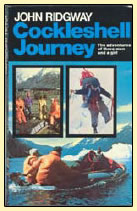 |
Cockleshell Journey By John Ridgway Hodder and Stoughton 1974 “You wanna go up there, in two ten-foot boats?” the captain asked. He gestured with his hands to emphasise the futility of the project. “That’s a helluva piece of country. These glaciers on the sides of the mountains – they’re just stuck on, waiting to come crashing thousands of feet down into the sea. There are rapids, here in the narrows; it’s not much over twenty yards wide and the icebergs are grounded by the tide. The cliffs are so high they blot out the radio. Apart from the icebergs grinding about in the channel, the glaciers will be calving now with the onset of spring. That will mean avalanches and tidal waves as a result. Out here on the Pacific coast there’s a terrific swell, and here, there’s a tidal-race.” Jabbing a stubby finger at the chart, the captain continued with his gloomy forecasts, eventually reaching a point where there really weren’t many more disasters left to be imagined. “We sure hate to lose good men,” he said. And so, in 1972, we began the first ever attempt at a crossing of the Gran Campo Nevado Ice-Cap. Eric Shipton had given me the idea; near the southern tip of South America there was a blank patch on the map, with ‘Inexplorado’ written across it. “To get there, you’ll need small boats,” he smiled, “and that’s the reason nobody has tried before. Mountaineers don’t take too well to water and it can be rather rough down there”. It was at the time of the Communist Revolution in Chile and everything was pretty much touch and go. We were a small team, with a couple of tents. Two of our JRAS Instructors, Richard Shuff and Krister Nylund shared one rubber dinghy, while Marie Christine and I travelled in the other. We had no means of communication with the outside world and at one stage we reckoned it would take six weeks to get help. During our trip, a plane came down in the Andes further to the north, and an Old Boys rugby team from Uruguay survived after the crash by eating the corpses. Although much of our own food was ruined by seawater, we never did quite reach that stage, making do with fish we caught and duck eggs and geese we shot. For the first time, we took our JRAS Instructors on the trip with us. It became the norm. There was a fair bit of drama but it was one of those grand trips where everything comes good and the end result seems nicely symmetrical. Postscript I wanted to try everything. After the Amazon it was time to have a go at the Andes. More practical leadership experience in a far away place. And how useful, when we returned twenty years later, trying to kayak round Cape Horn.
|
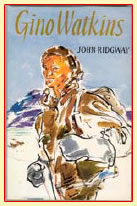 |
GINO WATKINS Written by John Ridgway Oxford University Press 1974 Gino Watkins was only twenty-five when he died – drowned in the Arctic waters of Greenland. Yet he had earned a reputation for himself such as few men twice his age enjoy. The leader of several major expeditions to Arctic terrain, he had won the respect of both elders and contemporaries through the strength of his mysterious personality. A passionate enthusiast for adventure, he was yet level-headed and shrewd; pleasure –loving, perhaps cynical in some ways, he was outstanding among explorers for his careful assembling of the details of the intractable wilds into which he journeyed. I tried to put myself in Gino’s position. Concentrating on what I could find of his background and the formative experience of his life, and then drawing from my own experiences, I went into the detail of the expeditions themselves and the hazards they would have encountered. Postscript One Christmas, when I was around twelve years old and very impressionable, I was given a book called ‘Men of Achievement’. What stuck in my mind – and hurried me along - was Gino’s bold belief that a man should have achieved everything he wanted in life, by the time he was twenty-five years old. I had never read anything like that before and by the time I was asked to write this biography I was already thirty-four! We had just returned from making the first crossing of the Gran Campo Nevado ice-cap in Patagonia, the “Cockleshell Journey”. After the Editor outlined his requirements I went straight round to the Royal Geographical Society in London and sat myself beside the very sealskin kayak in which Gino had drowned. I pictured myself in the frail slip of a thing, remembering a dark winter’s night, when Chay and I had capsized our kayak in a roaring weir on the Thames. And how we’d got going again, driving hard to dry ourselves, and eventually arriving at Westminster Bridge next morning, to win the Parachute Brigade Canoe Race. In the Society library, I studied treasured copies of magazines and books, recording Gino’s expeditions. There’s a timeless atmosphere about that old building beside Hyde Park. “Surely little has changed in the 43 years since Gino’s carefree laughter rang out here in this room?” I thought. But then it’s already 40 years since Chay and I rowed across the North Atlantic.
|
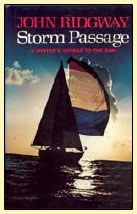 |
STORM PASSAGE Written by John Ridgway Hodder & Stoughton 1975 “The boat that can sail in October, will sail the world over!” cackled Granny Ross, from her rocking chair in the corner of the old stone croft house. Running the John Ridgway School of Adventure at Ardmore, means a family holiday must come in the winter season. And if it involves sailing a thirty-two foot sloop from the extreme north-west of Scotland to the Cape Verde Islands and back, between October and December, a degree of calculated risk is as inevitable as the seasickness. When the crew of six includes Marie Christine and our seven-year-old daughter Rebecca, it also brings an extra personal dimension and rather sharpens the observation of life on a fairly steep ocean wave, as seen by a small girl to whom a supermarket on Santa Cruz is as wondrous as a killer whale off the bow or an inquisitive submarine. This expedition to the Spanish Sahara, off the west coast of Africa, was the last chance for a long family holiday all together before Rebecca would have to go away to school. The dramas of sailing the brand new English Rose V home in mid-winter from the builder in Gosport to Ardmore, near Cape Wrath, might well have ended the notion of winter sailing in the North Atlantic as a suitable family hobby. But at the end of September 1974, the three of us did set sail – along with three of our trusty JRAS Instructors: Stafford Morse, Krister Nylund and Jamie Young. Not having an engine in this four-berth sloop affected our every move. Our ports of call included Madeira, where we took a walk across the island’s 5,000 foot volcanic plateau; Santa Cruz, the eerie wreck-strewn coastline of the Spanish Sahara where the great desert stretches down into the sea; and the impoverished Cape Verde islands. From there we set sail for the Azores, a green and bountiful last port before the long perilous voyage home, on the North Atlantic in December. This winter voyage had fun, misery, exhilaration and the apprehension in equal parts, suggesting to other yachtsmen that theirs may after all be an all the year round sport. Postscript This was my fifth book and this time I wrote it as soon as we returned. It took 29 continuous days of non-stop effort, aiming for flow and momentum. At the end of a whole month indoors I promptly went down with flu’! English Rose V was a fine yacht, a Nicholson 32 with all the modifications that being Mark Ten can bring. Specially built for us for long distance sailing, with a very strong and simple layout, this is a trip from the days before I realised how useful an engine could be in a sailing boat. We had all manner of scrapes and we were so lucky not to lose the boat in the storm off the west coast of Ireland a couple of days before Christmas. Perhaps it was a form of education for our dear daughter, Rebecca. But it did rather put her off sailing for a bit – and her Mother too….
|
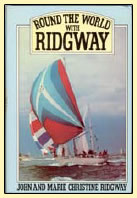 |
ROUND THE WORLD WITH RIDGWAY Written by John & Marie Christine Ridgway Heinemann 1978 There has never been a book or a film about an ocean yacht race like this one. We wanted to mark the tenth anniversary of the John Ridgway School of Adventure at Ardmore, on the far north west coast of Scotland, with an unusual adventure that could be undertaken while the School was closed for the winter. Together with a crew of our JRAS Instructors, Marie Christine and I decided to try and sail right round the world in the few months available. The core of the plan was that the adventure should be closely linked with our continuing work at Ardmore; so we chose a 57’ ketch that, while it may have lacked the lines of an ocean racer, would be most suitable for our sail-training at Ardmore. Eventually we decided to enter the 1977-8 Whitbread Round the World Yacht Race to lift our own performance. In this book, compiled largely from the separate diaries we kept throughout the nine-month voyage, we tell the whole story. From raising the finance, to the psychological and other pressures associated with life on board shared for long, hard weeks at sea in some of the toughest conditions in the world. Eleven men and one woman, united by a common aim but divided by age, temperament and experience. To add to the tension, a two-man TV crew was on board from beginning to end. They had a free hand to film and record the action and reaction above and below decks – the good times and the bad, the excitement of competitive sailing, the encounters with wild life and ice bergs, together with boredom, squalor and discomfort, explosions of anger and frustration. Postscript From start to finish, this was a real test. And I soon came to understand how Francis Drake executed his best friend while only a quarter of the way round the world on his own voyage. But owning and skippering the boat was such a valuable experience for me. In later years, this sort of television came to be called ‘Reality Television’. For us it was just as unsettling as anything you see on Big Brother nowadays, except it wasn’t for three weeks but nine months. I can only say how grateful I am that Marie Christine stuck it out to the very end.
|
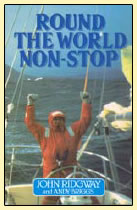 |
ROUND THE WORLD NON-STOP Written by John Ridgway and Andy Briggs Patrick Stephens 1985 In March 1984, JRAS Instructor Andy Briggs (24) and I (46) returned to Ardmore, in the far north west of Scotland, completing our 28,000 mile circumnavigation of the globe. We had sailed for 203 days non-stop, at the time it was the fastest non-stop sailing passage ever made round the world. We had set sail using only our own resources, without sponsorship or insurance, and for nearly seven months neither of us had averaged more than three hours sleep at a time. This book examines our contrasting motives for making the voyage, the physical and psychological hardships endured, as well as the moments of pure triumph and joy. From the exhilaration of the Southern Ocean roller coaster and rounding Cape Horn, to the unforgettable sight of the wandering albatross once more, the sea in all its moods and the sky darkened by Saharan dust. This book tells it how it was for each of the two, quite different, individuals. Illustrated by Andy Briggs’ detailed line drawings and including colour photographs taken during the voyage. Postscript The boat has been on many trips since this non-stop circumnavigation but I’ve had no better companion than Andy Briggs. I was forty-six at the time and those 203 days, spent more or less on my own (I slept while Andy was on watch and vice versa), gave me an opportunity to consider my future. I have always disliked looking back, never joining clubs or attending school or regimental reunions. At all costs I wanted to avoid becoming one of those poor souls consumed by an internal worm of bitterness. Alone on watch, on Day 118, Boxing Day 1983, I made an iron rule: Forget regrets. The next 45 years must be lived always looking toward the Future. The Save the Albatross voyage of 2003/4 is an expression of that determination of 1983.
|
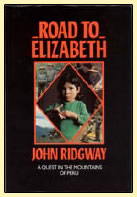 |
ROAD TO ELIZABETH Perhaps our most unlikely adventure. It started as a holiday journey in 1985, with Marie Christine and our 18-year-old daughter Rebecca, to a ‘Garden of Eden’ in the magnificent High Andes of Peru. Together with our JRAS Instructors Justin Matterson and Ed Ley-Wilson we were hoping to visit Elvin Berg, who had saved my life during my Amazon expedition of fifteen years before, and to stay at the coffee grower’s idyllic hacienda in Osambre. To reach Osambre (1,800m) you have to walk for five days from the end of a dirt road, crossing two snow-covered passes before descending into dense jungle. We trained for a month, hardening ourselves at altitude on the altiplano, before starting towards Osambre; we were prepared for a hard trek across some of the wildest and most beautiful terrain in the world, but not for what followed. After crossing the Apurimac River, which nearly cost Justin his life, we walked into a war between Maoist guerrillas of the so-called ‘Shining Path’ and government forces – our path lay through mountain regions where coca leaf is harvested in a deadly trade. Here we learned that Elvin Berg had been brutally murdered by the Shining Path on 2 May 1984. Horrified by Elvin’s death, anxious for our own safety and weakened by the hardships of the journey, we set off on the long road home. Along the way, I caught a fever and we were forced to stop in a remote mountain village. Here we discovered Elvin’s 6-year-old daughter Elizabeth: suddenly we realised that ‘everything had been leading to this end’. In Amazon Journey (1972) I described my expedition to the Peruvian Andes and the meeting with Elvin Berg at Osambre, the Berg’s mountain farm. Postscript Our last visit to was in 1994 and is included in Then we Sailed Away. Leaving the yacht in Andy Adamson’s safe hands in Valdivia, Marie Christine, Isso and I travelled up through Chile and Bolivia to Peru. Our aim was to reunite Isso with Leocadia, her natural mother. Of course, we were anxious lest Isso might choose to leave us and make her life with her family in Accobamba but happily for us she chose to return to Ardmore.
|
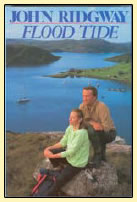 |
FLOOD TIDE Written by John Ridgway Hodder & Stoughton 1988 Ardmore is the pulse beat of Flood Tide. It is the windswept peninsula of rock and lochan to the north of Loch Laxford, where I pitched up one wet spring day forty-two years ago and where Marie Christine and I put down our roots. There are three generations of us living here now. On this remote seaboard of the North West Highlands of Scotland we built the John Ridgway School of Adventure in one of the least accessible corners of the British mainland. There is no road to Ardmore, and until 1981 there was no electricity. It is the place we always yearn to return to. It is where we work. The core of this book is how Marie Christine and I, with our young daughter Rebecca, became part of a dwindling crofting community. Gradually we were accepted among our neighbours – old men for the most part, living on their memories of lucky sea rescues, or notable herring gluts, of prowess at the Durness Highland Gathering and in the pub afterwards, or days when the sheep sales still took place in the north-west. At the time of writing this book, main issues revolved around the idea of a shellfish farm, the coming of electricity and the gradual departure of the local born population to the graveyard in Scourie. I was describing a life that has all-but disappeared now. But the seals, otters, badgers, sheep and foxes remain, along with the busy resident population of small birds in the wood. And each spring the grey lag geese, spying the green grass of Ardmore as they fly over Ben Stack, abandon their plans for Iceland, and circle down to nest on fox-free Chadh-fi Island. When the goslings hatch they swim across the smooth waters of the sea loch, to grow big and strong on the grassy hillside of the croft. We were running one of the UK’s most successful and long-established adventure schools at Ardmore, beside the most northerly wood on the West Coast of Britain. But I am also a crofter. The small patches of emerald green grazing were hard won with my scythe each year, from the bracken, rushes and the encroaching woodland. Countless years of covering with seaweed brought up from the shore, long before my time, have been helped by our own improvement with lime, basic slag and seed. That green grass is as precious to me as the hours of twilit escape to do battle with the canny brown trout of the hill lochans. Flood Tide is a story of success and failure, the teething troubles and slow growth to success of an unusual business enterprise, started by one of life’s natural pessimists. It tells of the launch of adventure courses - for young people, for ladies, businessmen, and the special team-building courses run for industry. It is the story, too, of people who helped run the place, like the succession of young Instructors and the indomitable Lance Bell who built most things and kept everything in working order, and his wife Ada, who even turned school ma’am when Rebecca was small. In describing how this dream developed, I try to describe my love for the wild, elusive and beautiful world of mountains, lochs and islands, in all their seasons. From the remoteness of Cape Wrath and the long white beach of Sandwood, to the sheer bird cliffs of Handa Island, and the snowy tops of Foinaven, Arkle and Ben Stack, home of ptarmigan, raven and eagle. By way of counterpoint, I describe the winter expeditions taken to recharge summer batteries, to the Spanish Sahara and Nepal, to Patagonia and the Amazon; and of setting off on our ‘magic carpet’, which is the loch at the foot of the croft, on two epic circumnavigations, one record-breaking. But we always return to Ardmore and the mooring under the wood in Loch a’Chadh-fi, to a world governed by tides and the seasons, which is our home. Postscript I never worked harder at a book than Flood Tide. Journey to Ardmore tells the story up to 1969 and I began writing Flood Tide in 1978. It took me ten years. Drawn from the daily diaries I’ve kept since 1958, much of it was written when heeled-over, on the 203-day non-stop sail round the world, with the portable typewriter propped up at a steep angle on the little chart table. And I remember how much Andy Briggs wished he’d had such an absorbing project to work on, just to distract his mind from those seven long months when we saw the land only once. Many years have passed since this book was published and sometimes I wonder if I should bring it all up to date. But there is so much else to do. Perhaps I might weave it round my visits to the Albatross in the Southern Ocean, spread over the past six decades….. |
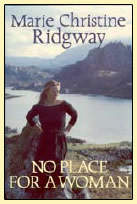 |
NO PLACE FOR A WOMAN Written by Marie Christine Ridgway Victor Gollancz 1991 & Victor Gollancz Paperback 1992 In 1964, aged just twenty, I married John Ridgway, a penniless Paratroop officer with a passion for adventure. Two years later John rowed across the North Atlantic with Chay Blyth, and their lives were changed forever. This achievement inspired us to set up our own school of adventure, beside the sea loch at Ardmore, where the North West Highlands sweep down to the lonely Atlantic, a dozen miles south of Cape Wrath, the top left hand corner of Scotland. In this harsh environment of paraffin lamps and peat fires, the girl who had worked at the Arts Council in London’s West End, found herself surrounded by macho escapists, marathon runners, round-the–world yachtsmen, rock climbers and fitness fanatics of every stripe. I decided to beat them by joining them. I’ve learned survival the hard way. I cooked, administrated and smoked salmon, as well as being a very keen gardener and a full-time wife to a formidable, hard driving but vulnerable man. I have accompanied John on his tough and always demanding adventures overseas. On one of these, we, as a family, decided to adopt Elizabeth Berg Huaman, a six-year-old Quechua Indian girl from the Peruvian jungle whose murdered father had saved John’s life on the Amazon fifteen years before. The story of this is told in his book Road to Elizabeth. In No Place for a Woman (the title refers to Ardmore itself). I try to tell the story of my life. But most of all, it is the story of a small brave girl from the jungle beyond the High Andes of Peru and her courageous struggle to adapt to her new life and family. Postscript Life has continued, at much the same hectic tempo. Our latest journey was sailing down to the Southern Ocean once more, John’s powers of persuasion as strong as ever. But this was a journey with a mission: to raise awareness to the plight of the albatross, which is threatened by extinction. John wrote a daily log from the yacht which was posted on our web site. It was hard to leave Bec and Isso behind, but at least they could follow our fortunes on the web. Isso has settled into life in Inverness, a long way from the small adobe hut in Peru, where we found her shivering with fright and hunger. Now quite the townie, with smart hairdo’s and the latest fashions. This time she wouldn’t be persuaded to join us. She had sailed with us on the 18-month family voyage, described in ‘Then We Sailed Away’. And she had been at the wheel one midnight, on our trip to Greenland when she shouted down to her dad “I think you had better come up and have a look at this”. While we were busy trying to save the Albatross, Bec stayed at Ardmore with her family, holding the fort. She well remembered the seasickness, telling me over the crackling phone that it puts into perspective, getting up at midnight to nurse an ailing child. But how I missed them all. Now we are home in the safe stone croft above the shore. The Adventure School is a memory and life is sweet. Until John dreams up something else that I won’t be able to say ‘no’ to.
|
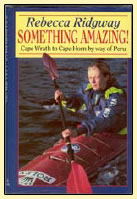 |
SOMETHING AMAZING Written by Rebecca Ridgway Hodder & Stoughton 1993 At the age of fifteen, I wanted to do ‘something amazing’. The chance came nine years later, in January 1992, when I became the first woman to paddle a kayak round Cape Horn. This adventure in stormy waters forms the climax of the book, but there were also a few other amazing things, which happened to me long before the final chapters. Dad has made a few waves and my upbringing had hardly been conventional and certainly not without challenges. I was an only child, reared on the gale-swept Ardmore peninsula fifteen miles south of Cape Wrath, Scotland’s top left-hand corner. Access is by sea, as there is still no road to Ardmore. For most of my childhood there was no electricity either. Milk was powdered, the Rayburn cooker peat-fired. I grew up in this beautiful and remote crofting community, which in summer became hectic with the activities of my parents’ Adventure School. How I remember being set-off first in a field of 80, on the fortnightly cross-country Great Race; it was like being a hare before the hounds. The family winter expeditions provided me with another quite different life. I was only seven when, on our way back from the Spanish Sahara, I found myself waist-deep in cold Atlantic water, over a hundred miles off the Irish coast, one Christmas Eve; it looked very much to me as if our tiny sailing boat was sinking. Just as tricky but a lot more rewarding were the trips to the headwaters of the Amazon. Deep in Shining Path terrorist country, we discovered the daughter of a murdered friend of my father, a small Peruvian-Indian girl who was to become my sister, Isso. Then there were the treks across the snow-covered Andean passes and down through the jungle, to trace members of my sister’s family cut off for years by Sendero guerrilla warfare. It’s hard to believe that in the end I was travelling on my own, with only my Quechua chum, Hippolyte as guide. The final chapters tell the story of the years of training and preparation leading me to the foot of that glacier, flowing down from Mt. Fitzroy on Tierra del Fuega, the start of my own trip. Countless paddle-strokes later my little kayak carried me round Cape Horn Island. Postscript Today I live down on the shore in the Beach House (it was the bunkhouse in JRAS days) with my family, busy running my own Ridgway Adventure across the loch at Skerricha. See www.ridgway-adventure.co.uk.
|
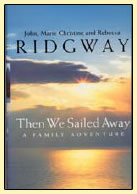 |
THEN WE SAILED AWAY Written by John, Marie Christine and Rebecca Ridgway Little, Brown 1996. Paperback Warner 1998 “We walked out, leaving the door unlocked, everything in confusion, as if we would return within the hour…..” One rainy October day in 1993, together with JRAS Instructors Andy Adamson and Will Burchnall, we sailed out of Ardmore, leaving behind our daily routines and all the challenges of running our School of Adventure in a remote corner of north-west Scotland. We were sailing away from the rocky peninsula that had been our home for the past quarter of a century. We were once more aboard our ‘magic carpet’, the 57’ ketch English Rose VI, which lies at her mooring, always waiting, on the sea loch at the foot of the croft. Uncertain of where we were going, we were nevertheless quite sure we’d be away for at least 18 months. It was goodbye to all the pressures of modern life. The ‘magic carpet’ took us anywhere the wind blew, on an extraordinary voyage, across the Atlantic and Pacific Oceans and back home again via Antarctica. We visited South Sea island paradises, and remote Andean villages, and braved windswept Patagonian wildernesses and fierce ocean storms. We also endured the trials of domestic life in a rather confined space, adopting a ginger kitten in Tahiti, to stroke and calm us down when things became tense. And we awaited a very special family reunion for our adopted daughter, Elizabeth (Isso), returning to her native Peruvian jungle for the first time. Postscript Marie Christine and I have retired and the ‘magic carpet’ is up the slipway for now. John Ridgway School of Adventure lets out the houses and Ridgway Adventure can supply adventurous activities on a daily basis if needed. Worn out by the ravages of the 1999 trip to Greenland, Andy just couldn’t face the inevitable seasickness of the 2003/4 Save the Albatross Voyage round the world. Instead he took-up an outdoor pursuits position in the south of Scotland. And I still miss his light in The Watcher’s House halfway down the hill. |
‘Save the Albatross’
Wing & a Prayer
2003/4After our voyage, I do feel I should have written a proper ‘Save the Albatross’ book. Perhaps I could link the six decades of my visits to the old bird and try to explain the inspiration I have found and why I feel so strongly that every effort should be made to prevent its needless extinction.
When we arrived home, IT people told us we had been “blogging” all the way round the world. That is to say, publishing a daily diary on the web. I have been keeping a diary of every day for the past 50 years, so when I wasn’t feeling seasick, I found the writing easy enough.
Perhaps my ‘blog’ is a book in a very long, rough form. But publishing every day brought it’s own constraints; for instance, crew-members from Non-Governmental Organisations (NGO’s), our guests on various Legs of the voyage, sometimes received notification of what had been written about themselves by satellite phone, almost at the instant of publication and were, mostly, amused. But with virtual strangers from organisations with differing agendas, it occasionally affected what might reasonably be written from the safety point of view in the prevailing circumstances. We wanted no distraction from the aim of our enterprise, which was to raise international awareness to the desperate plight of the Albatross.
19 of 21 species of Albatross are threatened with extinction. Long-line boats in the Southern Ocean fish tens of thousands of hooks on lines up to a hundred miles long. The Albatross takes the frozen squid bait before it sinks and is drowned.
Together with our stalwart chum, 1971 JRAS Instructor Nick Grainger, Marie Christine and I left Ardmore without sponsorship or insurance; our venture began in a very small way. But as we progressed, it certainly did grow. The South Africans took the dotty pensioners to their hearts. The Prime Minister of New Zealand made a fine speech for the Albatross when she started us off on the Leg from Wellington. And in the Falklands, the Governor was most supportive. Tower Bridge was lifted for the Albatross when we returned to London. And Marie Christine and I flew on to the United Nations in Rome with Euan Dunn of RSPB, where I presented our Save the Albatross Petition, which had raised 105,000 signatures from 131 countries on the web.
But had we made a difference? Well, following increased public interest, ‘Albatross Task Force’ was born, an initiative to get expert educators to sea with the fishing fleets in the Southern Ocean.
The survival of the Albatross will be assured if only we can get a willing skipper on every fishing boat.
Signed copies of books can be ordered, cost plus postage. Out-of-print copies can often be obtained from http://www.amazon.co.uk
CONTACT
Marie Christine Ridgway
Ardmore, Rhiconich, By Lairg, Sutherland IV27 4RB
Tel: (+44) 01971 521229
Fax: (+44) 01971 521463
Email: J.Ridgway@btinternet.com
Home | |
Books | |
